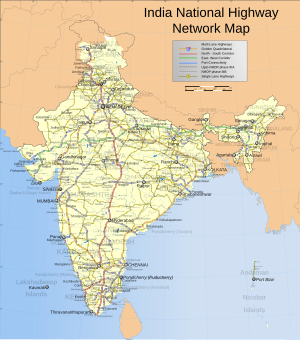
Back भारत में सड़क BH ভারতের সড়ক পরিবহন ব্যবস্থা Bengali/Bangla भारत में सड़कें HI بھارتی سڑکوں کا جال UR



Roads in India are an important mode of transport in India. India has a network of over 6,617,100 km of roads. As of Dec 2024, India has the largest road network in the world.[2] At (1.94 km, 1.21 mi) of roads per square kilometre of land, the quantitative density of India's road network is equal to that of Hong Kong, and substantially higher than the United States (0.71 km, 0.44 mi), China (0.54 km, 0.34 mi), Brazil (0.23 km, 0.14 mi) and Russia (0.09 km, 0.056 mi).[3] Adjusted for its large population, India has approximately 5.13 kilometres (3.19 mi) of roads per 1,000 people, which is much lower than United States 20.5 kilometres (12.7 mi) but higher than that of China 3.6 kilometres (2.2 mi). India's road network carries over 71% of its freight and about 85% of passenger traffic.[4]
Since the 1990s, major efforts have been underway to modernize the country's road infrastructure.[5] As of 31 March 2020, 70.00% of Indian roads were paved. As of 31 December 2023, India had completed and placed into use over 35,000 kilometres (22,000 mi) of four or more lane highways connecting many of its major manufacturing, commercial and cultural centres.[3] According to the Ministry of Road Transport and Highways, as of March 2021, India had about 151,019 kilometres (93,839 mi) of national highways and expressways, plus another 186,528 kilometres (115,903 mi) of state highways. Major projects are being implemented under the Bharatmala, a Government of India initiative. Private builders and highway operators are also implementing major projects.[6][7]
- ^ Table - Distribution of density of road network Archived 24 January 2012 at the Wayback Machine, Ministry of Roads Transport and Highways, Government of India (2013)
- ^ "Annual Report 2022-23, Ministry of Road Transport and Highways" (PDF). morth.nic.in. Ministry of Road Transport and Highways, Government of India. 31 December 2022. Archived (PDF) from the original on 18 September 2023. Retrieved 28 July 2023.
- ^ a b "Annual Report 2020-2021" (PDF). Ministry of Road Transport and Highways. Archived (PDF) from the original on 16 November 2021. Retrieved 31 March 2020.
- ^ "Annual Report 2020-2021" (PDF). NITI Aayog. 1 June 2021. Archived (PDF) from the original on 11 August 2021. Retrieved 11 August 2021.
- ^ "India en route for grand highways". BBC News. 26 May 2003. Archived from the original on 16 October 2011. Retrieved 30 November 2011.
- ^ Yamuna Expressway to open in April, trial runs on Archived 11 August 2017 at the Wayback Machine The Times of India
- ^ Gadkari to open 53-km stretch of Kundli-Manesar-Palwal expressway today Archived 23 September 2020 at the Wayback Machine hindustantimes (5 Apr 2016)